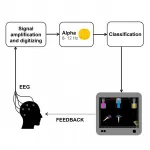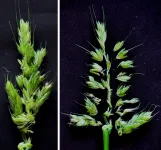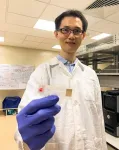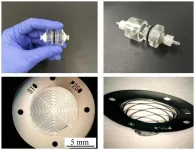Managing attention deficit disorder by training the brain
A team from the UNIGE and the HUG has found that a special type of brain training based on the principle of 'neurofeedback' enables people with attention deficit disorder to improve their ability to concentrate
2021-06-29
(Press-News.org) Attention Deficit Hyperactivity Disorder (ADHD) affects about 7% of children, with a two out of three chance of persisting into adulthood. This neurodevelopmental disorder is characterised by concentration difficulties, increased distractibility, impulsivity and hyperactivity. Today, ADHD is treated with pharmaceutical drugs that may have unwanted side effects. This is why scientists from the University of Geneva (UNIGE) and the University Hospitals of Geneva (HUG), Switzerland, explored a new technique called 'neurofeedback', which enables ADHD patients to train their attention, based on instant feedback from the level of their brain activity. The team of neuroscientists found that not only did the training have a positive effect on patients' concentration abilities, but also that the attention improvement was closely linked to an enhanced response from the brain- the P3 wave - which is known to reflect integration of information in the brain, with higher P3 amplitudes indicating greater attention towards detected targets. The findings are open-access and have been published in the journal Clinical Neurophysiology.
Attention Deficit Hyperactivity Disorder (ADHD) develops in childhood and leads to numerous difficulties with attention, concentration and impulsiveness. It has genetic associated with environmental causes, and is characterised by a deficit in dopamine, a neurotransmitter involved in executive functions. "These disorders persist for the most part into adulthood and lead to problems in relational and socio-professional functioning, making it easier for people with this disorder to turn to alcohol or drugs", notes Marie-Pierre Deiber, a researcher in the Department of Psychiatry at UNIGE Faculty of Medicine and at the HUG Division of Psychiatric Specialties.
Today, ADHD is treated with medications that increase the concentration of dopamine, which improves the patient's attention. As the disorder is often accompanied by depression, anxiety or even bipolar disorders, treatment is generally combined with psychotherapy. "However, pharmaceutical treatments can be accompanied by significant side effects, such as nervousness, sleep disturbance, but also an increased risk of developing other psychiatric disorders or cardiovascular diseases", explains Roland Hasler, a researcher in the HUG Division of Psychiatric Specialties. "This is why we wanted to investigate a completely non-pharmacological and non-invasive treatment based on the principle of 'neurofeedback'".
Sending the brain its own signals
Neurofeedback is a type of neurocognitive intervention based on the training of "real-time" brain signals. Using an electroencephalogram (EEG) with 64 sensors, the scientists capture the electrical activity of cortical neurons and focus their analysis on the spontaneous Alpha rhythm (with frequency around 10 Hertz), coupling its amplitude fluctuation to a video game that the patients can control with the power of their attention. "The aim of neurofeedback is to make the patients aware of the moments when they are no longer attentive. With practice, brain networks then "learn" to reduce attentional lapses through neuroplasticity", explains Tomas Ros, researcher in the Department of Basic Neurosciences at UNIGE Faculty of Medicine and at the Centre for Biomedical Imaging (CIBM). To do this, the patient's EEG is connected to a computer that displays the image of a space shuttle. When the patient is in an attentive brain state (low Alpha rhythm), this makes the space shuttle move forward. But as soon as the patient is distracted or loses attention (high Alpha rhythm), this stops the space-shuttle movement instantly. Faced with the stopping of the space shuttle, the patient realizes that he/she was no longer paying attention and refocuses to restart the shuttle.
Training the brain to focus without medication?
To measure the effects of neurofeedback training, the Geneva team administered an attention test to 25 adults with ADHD, and 22 neurotypical adults. The results showed that, at baseline, ADHD patients made more mistakes and had a more variable reaction time than the control participants, in line with a signature of impaired attention. After 30 minutes of neurofeedback training, the participants took the attention test again.
"The first finding was that stimulus detection and response variability were improved, indicating attentional enhancement", says Marie-Pierre Deiber. "But what interested us most was the impact of the neurofeedback training on the P3 component, which has previously been shown to be reduced in ADHD, and directly linked to the neurocognitive processing of the stimulus." The higher the amplitude of the P3, the more efficient the processing of the stimulus is, and the more accurate the response to the attention task. "The amplitude of the P3 increased significantly after neurofeedback training, and was directly associated with a reduction in the number of errors made by the patients", reports Tomas Ros.
This study firstly shows that a single 30-minute session of neurofeedback can induce short-term plasticity in the brain and encourages attentional improvements in ADHD patients. Secondly, it supports the existence of an electro-physiological marker of attentional processing in ADHD. "Thus, the P3 could be a cerebral signature that would allow us to better understand the neurocognitive mechanisms of ADHD", continues Nader Perroud, professor in the Department of Psychiatry at UNIGE Faculty of Medicine and at the HUG Division of Psychiatric Specialties. Finally, as the effects are evident in the short term, the scientists plan to carry out a neurofeedback treatment based on multiple training sessions, in order to observe whether the brain's plasticity is strengthened over time. "The ultimate goal is to enable patients to learn to concentrate without medication and to be able to train their brain in the comfort of their home», concludes Tomas Ros.
INFORMATION:
[Attachments] See images for this press release:

ELSE PRESS RELEASES FROM THIS DATE:
2021-06-29
An international team of researchers has identified a novel mechanism in barley plants, which could help crop growers achieve high yields as temperatures rise.
With grain production highly sensitive to changing environmental conditions, rising temperatures are known to reduce the number of seeds that can be produced on each plant. One solution is to increase the number of flowers or branches on each 'spike', which is the reproductive structure from which grain is harvested.
In a study published in Nature Plants, research led by Professor Dabing Zhang from the University of Adelaide's Waite Research Institute and Shanghai Jiao Tong University's Joint Lab for Plant Science and Breeding, explored the possibility of increasing seed production through ...
2021-06-29
Tsukuba, Japan - As far back as the 1930s, inventors have commercialized fuel cells as a versatile source of power. Now, researchers from Japan have highlighted the impressive chemistry of an essential component of an upcoming fuel cell technology.
In a study recently published in The Journal of Physical Chemistry Letters, researchers from the University of Tsukuba have revealed successive proton transport--energy transfer--in an advanced carbon-based crystal for future fuel cells, and the chemistry that underpins this phenomenon.
Such crystals are exciting as solid electrolytes--energy transfer media--in upcoming fuel cell technologies. Solid electrolytes have advantages, such as high power efficiency and long-term ...
2021-06-29
Researchers have revealed that praying mantis (mantids) infected with parasitic hairworms are attracted to horizontally polarized light that is strongly reflected off the surface of water, which causes them to enter the water. In a world-first, these research results demonstrate that parasites can manipulate the host's specific light perception system to their advantage, causing the host to behave in an abnormal manner.
This discovery was made by an international research group consisting of Graduate student OBAYASHI Nasono, Associate Professor SAKURA Midori and Associate Professor SATO Takuya of Kobe University's Graduate School of Science, Associate Professor IWATANI Yasushi (Faculty of Science and Technology, Hirosaki University), ...
2021-06-29
A team of scientists from Nanyang Technological University, Singapore (NTU Singapore) has developed a test kit for malaria that delivers results in 30 minutes. The kit could facilitate the diagnosis of malaria in the field, as the equipment needed is anticipated to be lightweight, easy-to-use, and able to detect the disease in its early stages.
According to the World Health Organisation (WHO), an estimated 229 million people suffered from malaria in 2019. The disease, transmitted by mosquitoes, caused the deaths of 409,000 people across 87 mainly developing countries.
Efforts to treat and control malaria in ...
2021-06-29
A microfilter device that can easily separate and capture trace amounts of cancer cells in blood has been developed by a Kumamoto University research group. The palm-sized device is expected to contribute to the development of new cancer diagnostic technologies based on cancer cells in the blood, such as early detection by blood test, postoperative management, and recurrence monitoring.
The blood of people with cancer contains trace amounts of cancer cells (CTCs) that have detached from the primary cancer site. However, the amount of these cells is only a few per milliliter, whereas red or white blood cells number in the billions, making ...
2021-06-29
INDIANAPOLIS - With the growing prevalence of chronic pain, depression, anxiety, and other symptom-based conditions, physicians and the healthcare systems for which they work are increasingly considering how to augment the care they can provide within the limited time allotted for patient appointments.
According to Regenstrief Institute Research Scientist Kurt Kroenke, M.D., writing in the Journal of General Internal Medicine (JGIM), collaborative care can and should play a major role targeting the treatment of symptoms and functional decline, both too frequently marginalized in medically oriented care delivery.
Collaborative care is a team-based ...
2021-06-29
Neoadjuvant immune checkpoint blockade (ICB) is a promising treatment for melanoma and other cancer types, and has recently been shown to provide a modest survival benefit for patients with recurrent glioblastoma. To improve the treatment efficacy, researchers are looking for vulnerabilities in surgically removed glioblastoma tissues, but this has been difficult due to the vast differences within the tumor and between patients.
To address this challenge, researchers at Institute for Systems Biology (ISB) and their collaborators developed a new way to study tumors. The method builds ...
2021-06-29
Sophia Antipolis - 29 June 2021: Heart attacks during the COVID-19 pandemic were more likely to result in heart failure compared with heart attacks one year earlier, according to research presented today at Heart Failure 2021, an online scientific congress of the European Society of Cardiology (ESC).1
"Heart attack patients waited an average of 14 hours to get help during the pandemic, with some delaying for nearly two days. That compares to a delay of six hours in the previous year," said study author Dr. Ali Aldujeli of the Hospital of Lithuanian University of Health Sciences, Kaunas, Lithuania. "This gap may have been one contributor to the higher incidence of subsequent heart failure."
Urgent treatment for heart attacks is essential to restore the flow of oxygen-rich ...
2021-06-29
Scientists have for the first time detected black holes eating neutron stars, "like Pac Man", in a discovery documenting the collision of the two most extreme and enigmatic objects in the Universe.
The Laser Interferometer Gravitational-Wave Observatory (LIGO) in the US and the Virgo gravitational-wave observatory in Italy have captured the gravitational waves from the death spiral and merger of a neutron star with a black hole, not once but twice. The findings are published today.
The researchers say their observations will help unlock some of the most complex mysteries of the Universe, including the building blocks of matter and the workings of space and time.
More than 1,000 scientists were involved with the ...
2021-06-29
As smoky air becomes more common during Washington's wildfire season, many wildlife enthusiasts wonder: What happens to the birds?
Few studies have looked at wildfire smoke impacts on animals, let alone birds. And as Washington and the larger West Coast continue to experience more massive wildfires and smoke-filled air, understanding how birds are affected by smoke -- and how air pollution may influence our ability to detect birds -- are important factors for bird conservation.
Researchers from the University of Washington now provide a first look at the probability of observing common birds as air pollution worsens during wildfire seasons. They found that smoke affected the ability to detect more than a third of the bird species studied ...
LAST 30 PRESS RELEASES:
[Press-News.org] Managing attention deficit disorder by training the brain
A team from the UNIGE and the HUG has found that a special type of brain training based on the principle of 'neurofeedback' enables people with attention deficit disorder to improve their ability to concentrate







